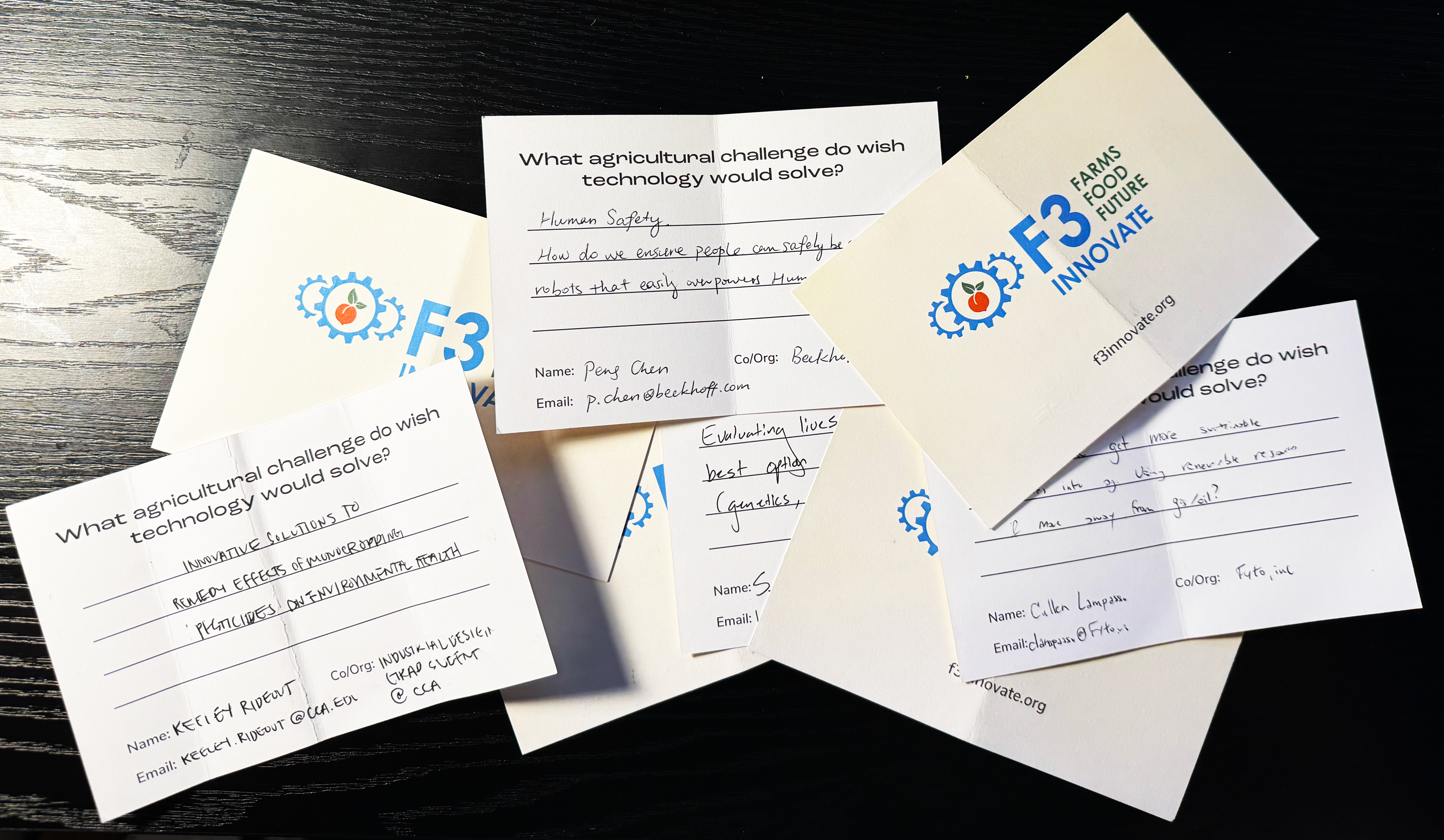FIRA USA 2024 was an incredible gathering of farmers, technologists, and thought leaders at the Yolo County Fairgrounds. Over three days, attendees explored the important role of technology in agriculture through robotics demonstrations, insightful discussions, and collaborative networking, demonstrating how innovation is driving solutions for some of agriculture’s biggest challenges.
One of highlights for us this year was the interactive drone raffle we hosted with F3Innovate. It was a simple but engaging way to crowdsource ideas from attendees—you! To enter, visitors just had to answer one question:
“What agricultural challenge do you wish technology could solve?”
The response was overwhelming. People shared thoughtful, creative, and practical ideas about the challenges they see in agriculture and how technology might help solve them. As we sifted through these responses, some clear themes emerged that reflect the priorities and aspirations of the agricultural community. Here’s a look at the ideas you shared and the topics that stood out during this crowdsourcing effort.
Labor and Workforce Solutions
Labor shortages have long been a challenge in agriculture, and this was echoed in many of the responses we received. Participants suggested a variety of creative solutions, from robots that could handle repetitive or physically demanding tasks to semi-automated systems designed to make planting, weeding, and harvesting more efficient.
One idea we loved was the integration of advanced technology with manual labor, coupled with tools and training to upskill farmworkers. This wasn’t just about making the work easier—it was about empowering workers to adapt to new technologies, creating opportunities for personal and professional growth while addressing critical labor gaps.
Sustainability and the Environment
Sustainability was another major theme. Attendees expressed a clear desire for tools and technologies that could help farmers reduce waste, limit pesticide use, and optimize irrigation practices. Many recognized the importance of protecting the environment while ensuring agricultural productivity, and their ideas reflected a strong commitment to balancing these goals.
Some responses focused on practical steps, like systems to minimize single-use plastics in farming, while others had bigger-picture ideas, like improving biodiversity and maintaining soil health to address the impact of monocropping. These ideas remind us of the deep connection between farming and environmental stewardship, and the incredible potential for innovation to drive meaningful change.
Improving Food Security
The topic of food security struck a chord with many participants. They shared ideas for reducing food waste, improving the quality and affordability of fresh produce, and strengthening local food systems. Technology has the potential to address many of these issues, whether through better logistics, enhanced storage methods, or tools that make it easier to grow food sustainably and efficiently.
A recurring idea was the importance of bridging the gap between producers and consumers. Many participants talked about the need to educate people about where their food comes from and why buying sustainably grown, locally sourced produce matters. This highlights a growing awareness of the importance of transparency in the food supply chain and the role of technology in encouraging that connection.
Optimizing Crops and Livestock
Farmers and agricultural experts are always looking for ways to optimize their operations, and the ideas in this category reflected that drive. Suggestions included better pest and disease detection systems to prevent crop loss and data-driven tools to help farmers make more informed decisions. Several people also talked about the potential of genetics and AI to improve livestock management, ensuring healthier animals and more efficient production.
These ideas illustrate the value of precision agriculture—using data and technology to target problems more effectively and minimize waste. Whether it’s in the field or in the barn, there’s a clear appetite for solutions that help farmers work smarter, not harder.
Adapting to Climate Change
Climate change is one of the biggest challenges facing agriculture, and it was no surprise that many responses touched on this theme. Participants highlighted the need for tools that could improve water efficiency, protect crops from extreme weather, and reduce the industry’s carbon footprint. From irrigation systems that conserve resources to technologies that help farmers track and manage greenhouse gas emissions, there’s a strong focus on climate resilience.
One suggestion that stood out was the development of systems to help farmers adapt to unpredictable weather patterns while maintaining productivity. This reflects a deep understanding of the interconnectedness between agriculture and the environment and the critical role farmers play in building a sustainable future.
A Community of Ideas
A huge thank you to everyone who stopped by our pavilion and shared their ideas. The suggestions we gathered reminded us why collaboration is so important. Every idea, big or small, contributes to a vision of agriculture that is more sustainable, inclusive, and resilient—one that prioritizes not only the challenges of today but also the opportunities of tomorrow. We’re excited to explore these challenges further and see how we can work together to turn ideas into action.
Let’s Stay Connected
Let’s keep the conversation going! Follow F3 Innovate on LinkedIn and check out their website to learn more about their work driving climate-smart agrifood technology development and commercialization in California’s Central Valley. Also, don’t forget to connect with The VINE on LinkedIn to explore how UC ANR’s innovation arm is advancing agricultural technology.

